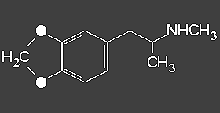The Party Drug

ECSTASY - E, eccies, love drug, XTC, doves.
We live in a world that is filled with little temptations and unfortunately for some, the temptation of drugs can sometimes prove too great. In fact, for a small percentage, use is often chaotic and at problematic levels. We live in a drug-taking society and while that statement in itself is no big surprise, what is surprising is the number of young drug users in our community.
In 1996, fifteen-year-old Sydney schoolgirl Anna Wood died after taking an ecstasy pill while at a local dance party. She was found with traces of ecstasy, cannabis and benzodiazepines in her blood and after lapsing into a coma; died a few days later from lack of oxygen to her brain, most likely caused by vomiting.
MDMA (Methylene-Dioxy MethAmphetamine) is commonly known as "ecstasy" and in recent years, use of the drug has been on the rise, in part because of the popularity of large, organised, all-night social gatherings known as "raves". Dubbed the "party drug", ecstasy use has been reported most frequently among young adults and adolescents at clubs, raves and even rock concerts.
 Today young people are experimenting with the so-called "love drug" ecstasy in increasing numbers, and as with the Anna Wood case, sometimes with fatal consequences. For many young adults, the rave culture that has popularised ecstasy dominates their social life. "E" friendships are made during drug-induced bouts of warmth and affection on the dance floor. Because of these "E" friendships, ecstasy is often referred to as the "we" drug where individuals are propelled and encouraged to step outside themselves and enjoy a communal experience.
Today young people are experimenting with the so-called "love drug" ecstasy in increasing numbers, and as with the Anna Wood case, sometimes with fatal consequences. For many young adults, the rave culture that has popularised ecstasy dominates their social life. "E" friendships are made during drug-induced bouts of warmth and affection on the dance floor. Because of these "E" friendships, ecstasy is often referred to as the "we" drug where individuals are propelled and encouraged to step outside themselves and enjoy a communal experience.
One of the lures of ecstasy is that it is consumed in a convenient pill form that is easy to hide and cheap to support at $50 a pop. It is usually sold as small white or yellow tablets that are swallowed. There have also been instances where people have injected themselves with MDMA.
MDMA is a drug that can cause users to see things that are not seen by other people and typically produces a feeling of tranquility, increased confidence and feeling close to people as our two case studies will demonstrate. People can also experience jaw clenching, teeth grinding, dry mouth and throat, nausea and loss of appetite, anxiety, paranoia and confusion. The next day a severe "hangover" may leave the user feeling "burnt out". Overdose can occur resulting in very high blood pressure, increased heartbeat and body temperature.
There is not much known about the long-term effects of ecstasy but there is some suggestion that it may damage some types of brain cells. Ecstasy is one of a growing number of "designer drugs" and many new variations are already available with more anticipated. According to a study that was carried out recently, heavy use of the drug ecstasy can lead to persistent problems in remembering what is seen and heard. This is related to the damage ecstasy does to particular brain cells that use the chemical serotonin for communication
As with other illegally bought drugs, the danger is that people who are purchasing MDMA are often buying the drug mixed with other substances. These substances can have a range of unpleasant or harmful effects. There have also been cases where aspirin has been sold as ecstasy.
The chemical structure of MDMA is similar to the structure of both amphetamines (speed) and some hallucinogens. Amphetamines are stimulants and directly affect the central nervous system by speeding up the activity of certain chemicals in the brain. Hallucinogens are drugs that can cause hallucinations - seeing, hearing, feeling or smelling things that don't exist. Hallucigens include drugs like LSD.
- Annemarie Failla
We live in a world that is filled with little temptations and unfortunately for some, the temptation of drugs can sometimes prove too great. In fact, for a small percentage, use is often chaotic and at problematic levels. We live in a drug-taking society and while that statement in itself is no big surprise, what is surprising is the number of young drug users in our community.
In 1996, fifteen-year-old Sydney schoolgirl Anna Wood died after taking an ecstasy pill while at a local dance party. She was found with traces of ecstasy, cannabis and benzodiazepines in her blood and after lapsing into a coma; died a few days later from lack of oxygen to her brain, most likely caused by vomiting.
MDMA (Methylene-Dioxy MethAmphetamine) is commonly known as "ecstasy" and in recent years, use of the drug has been on the rise, in part because of the popularity of large, organised, all-night social gatherings known as "raves". Dubbed the "party drug", ecstasy use has been reported most frequently among young adults and adolescents at clubs, raves and even rock concerts.
 Today young people are experimenting with the so-called "love drug" ecstasy in increasing numbers, and as with the Anna Wood case, sometimes with fatal consequences. For many young adults, the rave culture that has popularised ecstasy dominates their social life. "E" friendships are made during drug-induced bouts of warmth and affection on the dance floor. Because of these "E" friendships, ecstasy is often referred to as the "we" drug where individuals are propelled and encouraged to step outside themselves and enjoy a communal experience.
Today young people are experimenting with the so-called "love drug" ecstasy in increasing numbers, and as with the Anna Wood case, sometimes with fatal consequences. For many young adults, the rave culture that has popularised ecstasy dominates their social life. "E" friendships are made during drug-induced bouts of warmth and affection on the dance floor. Because of these "E" friendships, ecstasy is often referred to as the "we" drug where individuals are propelled and encouraged to step outside themselves and enjoy a communal experience.One of the lures of ecstasy is that it is consumed in a convenient pill form that is easy to hide and cheap to support at $50 a pop. It is usually sold as small white or yellow tablets that are swallowed. There have also been instances where people have injected themselves with MDMA.
MDMA is a drug that can cause users to see things that are not seen by other people and typically produces a feeling of tranquility, increased confidence and feeling close to people as our two case studies will demonstrate. People can also experience jaw clenching, teeth grinding, dry mouth and throat, nausea and loss of appetite, anxiety, paranoia and confusion. The next day a severe "hangover" may leave the user feeling "burnt out". Overdose can occur resulting in very high blood pressure, increased heartbeat and body temperature.
There is not much known about the long-term effects of ecstasy but there is some suggestion that it may damage some types of brain cells. Ecstasy is one of a growing number of "designer drugs" and many new variations are already available with more anticipated. According to a study that was carried out recently, heavy use of the drug ecstasy can lead to persistent problems in remembering what is seen and heard. This is related to the damage ecstasy does to particular brain cells that use the chemical serotonin for communication
As with other illegally bought drugs, the danger is that people who are purchasing MDMA are often buying the drug mixed with other substances. These substances can have a range of unpleasant or harmful effects. There have also been cases where aspirin has been sold as ecstasy.
The chemical structure of MDMA is similar to the structure of both amphetamines (speed) and some hallucinogens. Amphetamines are stimulants and directly affect the central nervous system by speeding up the activity of certain chemicals in the brain. Hallucinogens are drugs that can cause hallucinations - seeing, hearing, feeling or smelling things that don't exist. Hallucigens include drugs like LSD.
- Annemarie Failla
MORE





